-
On this page
Survey summary
The survey provides insights into the needs of the practitioners delivering Australia’s freedom of information (FOI) system.

Survey response
The 2024 OAIC FOI practitioners’ survey was conducted as an online survey of primary FOI contact officers of Australian Government agencies.
71%
response rate
147
agencies completed the survey
Areas responsible for managing FOI obligations
Legal sections, followed by corporate teams, were most likely to be responsible for meeting FOI obligations, including:
- processing FOI requests
- making decisions on FOI requests
- responding to requests for information regarding IC reviews or complaints
- Information Publication Scheme responsibilities
![]()
Agency-wide understanding and coordination of the FOI request process and proactive release obligations are critical to success
Systems
There are opportunities for agencies to improve systems, which would make complying with FOI obligations easier.
Records management
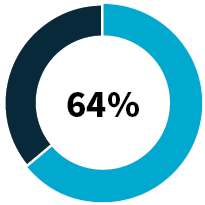
use multiple different records management systems
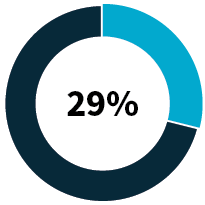
use an integrated records management system
![]()
Using an integrated records management system makes searching and retrieving documents more efficient
Document management policies

have only policies required under the relevant record keeping authority to manage records
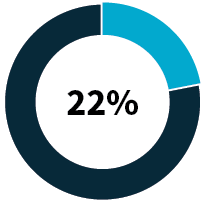
have comprehensive policies that cover all forms of records, including messaging services
![]()
Having comprehensive policies for documents might help with managing records and searching for records for an FOI request
Managing and reporting on FOI requests
![]()
63%
use an Excel spreadsheet to manage and report on FOI requests or other static record
![]()
26%
use a case management system
![]()
Using a case management system might help to track cases, meet obligations under the FOI Act and identify trends to support proactive publication
FOI Act training
Most agencies use informal, on-the-job training and internal resources for FOI Act training.


use informal, on-the-job training

use internal resources
![]()
Consider opportunities to expand and formalise training offerings and programs to ensure agency staff are well-equipped to meet FOI Act obligations
Guidance
The top 5 subjects practitioners would like guidance on are:
- conditional exemptions
- exemptions
- decision making
- procedural requirements
- practical refusals.
How and when are agencies using OAIC resources?
58% or more
use OAIC resources at least monthly, with many using them more frequently
82%
reported the FOI Guidelines as the most used resource
84%
are subscribed to OAIC’s ICON alerts
Message from the Freedom of Information Commissioner
Welcome to the Freedom of Information (FOI) Practitioners’ Survey 2024 report.
As a regulator focused on improving access to government-held information, it is essential that the Office of the Australian Information Commissioner (OAIC) has a full and comprehensive understanding of the needs of those delivering the FOI system – the practitioners.
Our goal is to drive agency compliance and support better practice, while being mindful of changes in the operating environment. This survey can assist in identifying the ways that environment is changing and the resulting needs of agencies and practitioners. It also builds upon the intelligence gained from the most recent review of the Australian government agencies’ Information Publication Scheme (IPS), conducted by the OAIC in conjunction with agencies in 2023.
The Practitioners’ Survey provides robust information that can shape the exercise of the OAIC’s FOI functions, including the provision of targeted guidance to agencies. For example, the survey will inform a review of Part 13 of the FOI Guidelines to ensure it reflects our digital operating environment and more effectively promotes compliance.
Interesting findings from the survey include that 82% of agencies reported the FOI Guidelines were the most used resource to assist them in performing their FOI Act functions. Over half of agencies use OAIC resources at least weekly (32%), fortnightly (13%) or monthly (13%).
Another notable finding is that agencies with integrated records management systems and comprehensive records management policies rated their ability to manage FOI requests more positively than other agencies.
The OAIC looks forward to using these and other findings to align and inform our approach to support agencies to achieve better outcomes consistent with the IPS and the FOI Act, and to embed a positive culture of compliance.
Toni Pirani
Freedom of Information Commissioner
January 2025
Executive summary
ORIMA Research was commissioned by the Office of the Australian Information Commissioner (OAIC) to conduct a Freedom of Information (FOI) Practitioners’ survey of FOI practitioners working in Australian Government agencies.
The aim of this survey is to strengthen the OAIC’s understanding of agencies’ needs in relation to their FOI practices, and to inform its exercise of the FOI functions. A component of this is the provision of targeted guidance to agencies.
The survey was conducted between 15 July and 13 August 2024. 147 Australian Government agencies (71% of those invited to take part) completed the survey. The survey captured a high proportion of larger agencies and agencies with a high number of FOI requests.
Specifically:
33 of the responding agencies were large or extra-large agencies (1000+ staff employed), (87% of agencies in this size category), and 27 of the responding agencies had a high or very high number of FOI requests (over 100 requests) in 2022-23 (representing 90% of these agencies).
Agency practices used to manage FOI requests
Systems and policies used to manage FOI requests
The survey found that agencies with integrated records management systems and comprehensive records management policies rated their ability to manage FOI requests more positively than other agencies:
- 64% of agencies reported having multiple different electronic records management systems (ERMS), while 29% reported having integrated ERMS (6% reported other systems). Agencies that have an integrated ERMS reported it to be more effective on average in both managing records (7.40 out of 10) and searching for records (7.42) in response to an FOI request than agencies that have multiple different ERMS (6.89 and 6.89, respectively).
- 75% of agencies reported having policies as required under the relevant record keeping authority, while 22% reported having comprehensive policies that cover all forms of records (3% reported other policies). Agencies that have comprehensive policies reported it to be more effective on average in both managing records (7.84 out of 10) and searching for records (7.72) in response to an FOI request than agencies that have policies as required (6.70 and 6.58, respectively).
Areas responsible for managing obligations under the FOI Act
Agencies most commonly reported that legal areas (41% to 55%) followed by corporate areas (30% to 47%) had responsibility for managing aspects of their obligations under the Freedom of Information Act 1982 (FOI Act). Business areas also commonly played a role in making decisions on FOI requests (28%) but were less likely to be involved in other aspects.
14% of agencies reported that they provide administrative support for the management of FOI functions to a minister. These agencies most commonly manage this responsibility in their legal area (67%) or a ministerial support branch or unit (33%).
FOI reporting systems and approaches
63% of agencies reported using an Excel spreadsheet or other static record to manage and report on FOI requests, while 26% use a case management system (most commonly LEX, Microsoft Dynamics and SharePoint).
- Case management systems were much more likely to be used by large or very large agencies (61%), than medium (27%) or small agencies (13%).
65% of agencies indicated they provide reports on FOI functions to their Executive or Board, with 34% providing reports to a Director and 17% to an Audit and Risk Committee. Eight per cent of agencies (mostly small agencies with a low number of FOI requests) indicated they had no FOI reporting arrangements in place.
- Over half of reports to a Director (51%) or Deputy Secretary (78%) were provided on a weekly or monthly basis, compared with 44% of reports to an Executive or Board. Seventy-six per cent of reports to an Audit and Risk Committee were provided on a quarterly basis.
Training and guidance
Most agencies use informal, on the job training (79%) and internal resources (69%) to provide FOI Act training within their agency, while 42% provide this training via the AGS and 39% via their internal legal services. These four methods were used as the primary training method by between 17% to 28% of agencies and a secondary training method by other agencies. While 28% of agencies used internal online training and 17% used service providers to deliver FOI training, these were predominantly used as secondary training methods.
82% of agencies reported that the FOI Guidelines were the most used resource to assist them in performing their FOI Act functions, with 7% indicating they relied more on guidance provided by the Australian Government Solicitor (AGS).
- Over half of agencies (58%) indicated they use OAIC resources regularly: at least weekly (32%), fortnightly (13%) or monthly (13%). Around one-third of agencies reported using them occasionally, while 11% indicated they use them rarely or never use them.
When asked to rank OAIC resources from most (1) to least (5) frequently used, FOI Guidelines clearly recorded the highest usage rank (1.24). The usage rankings recorded by the remaining OAIC resources, in descending order, ranged from the FOI Essentials Toolkit (3.01), General website publications (3.29), the IC Review Procedure Direction (3.51) to the ICON alert (3.99). All OAIC resources recorded an average helpfulness rating of over 6.5 out of 10. There was a strong positive correlation between the resources’ average frequency of usage ranking and its helpfulness rating (which ranged from 6.58 for the ICON alert to 8.61 for the FOI Guidelines).
Future needs
When asked to rank types of guidance from most (1) to least (4) helpful, fact sheets/aids to explain specific issues recorded the highest helpfulness rank (1.70), followed by templates to use in exercising functions (2.60), e-learning modules to explain the operation of the FOI Act (2.65) and training in decision making (3.04).
- When asked about other types of guidance they find helpful in responding to FOI requests, agencies cited AGS guidance; specific templates, flow charts and process guidance (often related to timelines and process steps); and IC review matters and decisions.
Agencies were asked to select up to three formats that are or would be most effective in providing guidance on FOI matters. Around three-quarters of agencies indicated that templates (74%) and targeted written guidance (73%) were the most effective formats, while checklists (57%) and e‑learning modules (48%) were also commonly selected.
More than 60% of agencies reported that the following five subject matter guidance topics would assist them most in responding to FOI requests:
- Conditional exemptions (73%)
- Exemptions (71%)
- Decision making (68%)
- Procedural requirements (64%)
- Practical refusals (63%).
84% of agencies indicated that relevant staff are subscribed to receive the OAIC’s ICON alerts. This was most commonly through individual staff subscriptions (58%), while 38% subscribed through a shared mailbox (e.g. the FOI operational mailbox).
Introduction
Research objectives
In July 2024, ORIMA Research was commissioned by the Office of the Australian Information Commissioner (OAIC) to conduct a Freedom of Information (FOI) practitioners’ survey of FOI practitioners working in Australian Government agencies. The OAIC’s FOI functions are defined in section 8 of the Australian Information Commissioner Act 2010 (AIC Act) and include:
- promoting awareness and understanding of the FOI Act
- providing information, advice, assistance and training relevant to the FOI Act
- monitoring and reporting on agencies’ compliance with the FOI Act, and
- issuing guidelines under s 93A of the FOI Act.
The aim of this survey is to strengthen the OAIC’s understanding of agencies’ needs in relation to their FOI practices, and to inform its exercise of the FOI functions, including to provide agencies with targeted guidance. This report presents the findings of the 2024 OAIC FOI practitioners’ survey.
Research methodology
The 2024 OAIC FOI practitioners’ survey was conducted as an online survey of primary FOI contact officers of Australian Government agencies.
The survey fieldwork period was conducted between 15 July and 2 August 2024. Fieldwork was extended to 13 August 2024, to give agencies more time to consolidate their responses across all sections of the agency and provide opportunities for some larger agencies that requested more time in filling in their responses. Fieldwork was extended to boost the overall response rate, ensuring agencies of all sizes were represented in the final data.
The OAIC provided ORIMA Research with the contact details for the primary FOI contacts for 206 agencies to participate in this survey. Agency characteristics such as agency size and number of FOI requests for each agency were acquired using data previously gathered for the 2023 IPS Agency Survey, and publicly available information from the Australian Public Service Commission (APSC) website. Of the 206 agencies, a total of 147 completed the survey, representing a response rate of 71%.
Before the fieldwork commenced, the Assistant Commissioner FOI informed agencies of the upcoming survey via email and indicated that ORIMA Research had been engaged to conduct the survey on behalf of the OAIC. The survey was also publicised in the OAIC’s ICON Alert and Information Matters newsletters.
Characteristics of responding agencies
The OAIC provided ORIMA Research with the sample of the primary FOI contact officers for relevant agencies, along with their size (based on the number of staff) and number of FOI requests received in 2023 where data were available.
The table below shows the splits of agencies across the size and number of FOI requests by the total sample and number of completions and response rates. This table also demonstrates that the survey recorded high response rates of at least 75% for medium, large and extra-large agencies and at least 86% for agencies with a medium, high or very high number of FOI requests.
Agency Size[1] | Sample | Completions | Response rate |
|---|---|---|---|
Micro agency (less than 20 staff) | 24 | 14 | 58% |
Extra small agency (20 – 100 staff) | 36 | 29 | 81% |
Small agency (101 – 250 staff) | 38 | 30 | 79% |
Medium agency (251 – 1,000 staff) | 37 | 30 | 81% |
Large agency (1,001 – 10,000 staff) | 34 | 30 | 88% |
Extra-large agency (more than 10,000 staff) | 4 | 3 | 75% |
Unspecified | 33 | 11 |
|
Number of FOI requests[2] | |||
None (0 requests) | 53 | 23 | 43% |
Low (1 – 10 requests) | 67 | 49 | 73% |
Medium (11 – 100 requests) | 56 | 48 | 86% |
High (101 – 500 requests) | 21 | 19 | 90% |
Very high (more than 500 requests) | 9 | 8 | 89% |
Total | 206 | 147 | 71% |
Presentation of results
The 2024 FOI practitioners’ survey was programmed to allow agencies to submit fully or partially completed responses. Only agencies that completed the submission process contained on the final page of the survey have been included in this report.
Percentages shown in this report are based on the total number of respondents to the survey (n=147), except where the question did not apply to them. In these cases, the percentages in the report are based on the number of respondents where the question applied to them.
Percentage results throughout the report may not add up to 100% due to rounding, or where questions allow for respondents to provide more than one answer.
Quality standards
This project was conducted in accordance with the international quality standards ISO 20252 and ISO27001, and the Australian Privacy Principles contained in the Privacy Act 1988.
Survey findings
Agency practices used to manage FOI requests
Systems used to manage records for the purposes of the FOI Act
Figure 1 below shows that 64% of agencies reported having multiple different electronic records management systems (multiple different ERMS) to manage their records, while 29% of agencies reported having an integrated electronic records management system (integrated ERMS) (6% reported other systems).
Figure 1: What system does your agency have in place to manage records?
Base: All agencies (n=146). Agencies could only select one response option.

Q1. What systems does your agency have in place to manage records?
When asked to rate on a scale of 1-10 how effective these systems are for managing records and for searching for records in response to an FOI request, agencies reported an average score of 6.94 and 6.95, respectively.
Agencies that have an integrated ERMS reported it to be more effective on average compared to agencies that have multiple different ERMS in both managing and searching for records in response to an FOI.
Effectiveness of systems
Base: All agencies (n=146). Ratings range from 1 (not effective at all) to 10 (very effective).
Managing all records | Searching for records |
|---|---|
| Agencies reported an average score of 6.94 in the effectiveness of their systems in managing records | Agencies reported an average score of 6.95 in the effectiveness of their systems in searching for records |
Ratings across system types: Multiple Different ERMS: 6.89 Integrated ERMS: 7.40 | Ratings across system types: Multiple Different ERMS: 6.89 Integrated ERMS: 7.42 |
Q2. On a scale of 1-10, how effective are these systems for managing all records, including encrypted messages for proactive release and in response to an FOI request?
Q3. On a scale of 1-10, how effective are these systems in searching for records in response to an FOI application?
Agencies’ ratings of the effectiveness of their systems in managing all records were similar between agencies of different size categories and between agencies with different numbers of FOI requests.
Agencies with integrated ERMS recorded higher effectiveness ratings in managing all records than those with multiple different ERMS across most size and number of FOI request categories. The exception to this was agencies with a low number of FOI requests.
Average effectiveness score: 1 (not effective at all) to 10 (very effective) | |||||
|---|---|---|---|---|---|
By agency size |
| Small | Medium | Large | |
All System Types | 7.10 (n = 72) | 6.67 (n = 30) | 6.84 (n = 32) | ||
Multiple Different ERMS | 7.09 (n = 43) | 6.95 (n = 20) | 6.71 (n = 24) | ||
Integrated ERMS | 7.22 (n = 27) | 7.86 (n = 7)* | 7.50 (n = 6)* | ||
By number of FOI requests |
| Low | Medium | High | |
All System Types | 6.90 (n = 49) | 7.11 (n = 47) | 6.81 (n = 26) | ||
Multiple Different ERMS | 7.33 (n = 30) | 6.90 (n = 30) | 6.60 (n = 20) | ||
Integrated ERMS | 6.88 (n = 16) | 7.81 (n = 16) | 8.33 (n = 3)* | ||
Note: Agencies that answered “Other’ as a system type are not listed in the table above due to small sample sizes, however, they are included in the averages for “All system types”.
*Caution should be used when interpreting results that are calculated from a small number of relevant agencies.
Q2. On a scale of 1-10, how effective are these systems for managing all records, including encrypted messages for proactive release and in response to an FOI request?
Agencies which are larger and have a high number of FOI requests tended to score lower in their ratings of the effectiveness of their systems in searching for records. The average score in the effectiveness of systems in searching for records ranged between:
- 6.39 for large-sized agencies to 7.18 for small-sized agencies, and
- 6.63 for agencies with a high number of FOI requests to 7.09 for agencies with a medium number of FOI requests.
Agencies with integrated ERMS recorded higher effectiveness in searching for records than those with multiple different ERMS for medium and large agencies and for medium and high numbers of FOI requests.
Average effectiveness score: 1 (not effective at all) to 10 (very effective) | |||||
|---|---|---|---|---|---|
By agency size |
| Small | Medium | Large | |
All System Types | 7.18 (n = 72) | 6.87 (n = 30) | 6.39 (n = 33) | ||
Multiple Different ERMS | 7.23 (n = 43) | 7.10 (n = 20) | 6.20 (n = 25) | ||
Integrated ERMS | 7.22 (n = 27) | 8.00 (n = 7)* | 7.33 (n = 6)* | ||
By number of FOI requests |
| Low | Medium | High | |
All System Types | 6.94 (n = 49) | 7.09 (n = 47) | 6.63 (n = 27) | ||
Multiple Different ERMS | 7.40 (n = 30) | 6.80 (n = 30) | 6.48 (n = 21) | ||
Integrated ERMS | 6.88 (n = 16) | 7.81 (n = 16) | 8.00 (n = 3)* | ||
Note: Agencies that answered ‘Other’ as a system type are not listed in the table above due to small sample sizes, however, they are included in the averages for ‘All system types’.
*Caution should be used when interpreting results that are calculated from a small number of relevant agencies
Q3. On a scale of 1-10, how effective are these systems in searching for records in response to an FOI application?
Policies used to manage records for the purposes of the FOI Act
Figure 2 shows that 75% of agencies reported having “policies for documents as required under the relevant record keeping authority” to manage their records, while 22% of agencies reported having “comprehensive policies that cover all forms of records, including text messages, encrypted messaging (e.g. WhatsApp)” (3% reported other policies).
Figure 2: What policies does your agency have in place to manage records?
Base: All agencies (n=146). Agencies could only select one response option.

Q4. What policies does your agency have in place to manage records?
When asked to rate the effectiveness of these policies on a scale of 1-10, agencies recorded an average score of 6.91 for managing all records (including encrypted messages for proactive release and in response to an FOI request) and an average score of 6.79 for searching for records in response to an FOI application.
Agencies that have comprehensive policies reported them to be more effective on average, as compared to agencies that have policies as required under the relevant record keeping authority, in both managing and searching for records in response to an FOI.
Effectiveness of policies
Base: All agencies (n=146). Rating ranges from 1 (not effective at all) to 10 (very effective).
Managing all records | Searching for records |
|---|---|
| Agencies reported an average score of 6.91 in the effectiveness of their systems in managing records | Agencies reported an average score of 6.79 in the effectiveness of their systems in searching for records |
Ratings across policy types: Policies as required: 6.70 Comprehensive policies: 7.84 | Ratings across policy types: Policies as required: 6.58 Comprehensive policies: 7.72 |
Q5. On a scale of 1-10, how effective are these policies for managing all records, including encrypted messages for proactive release and in response to an FOI request?
Q6. On a scale of 1-10, how effective are these policies in searching for records in response to an FOI application?
Agencies’ ratings of the effectiveness of their policies in managing all records tended to be slightly higher for medium sized agencies and agencies with a medium number of FOI requests than other agencies.
Agencies with comprehensive policies recorded higher effectiveness ratings in managing all records than those with policies as required across all size and number of FOI request categories.
Average effectiveness score: 1 (not effective at all) to 10 (very effective) | |||||
|---|---|---|---|---|---|
By agency size |
| Small | Medium | Large | |
All Policy Types | 6.90 (n = 72) | 7.10 (n = 30) | 6.79 (n = 33) | ||
Policies as Required | 6.66 (n = 58) | 7.17 (n = 23) | 6.22 (n = 18) | ||
Comprehensive Policies | 8.08 (n = 13) | 8.25 (n = 4)* | 7.50 (n = 14) | ||
By number of FOI requests |
| Low | Medium | High | |
All Policy Types | 6.82 (n = 49) | 7.17 (n = 47) | 6.74 (n = 27) | ||
Policies as Required | 6.48 (n = 40) | 7.16 (n = 32) | 6.29 (n = 17) | ||
Comprehensive Policies | 8.63 (n = 8)* | 7.83 (n = 12) | 7.50 (n = 10) | ||
Note: Agencies that answered ‘Other’ as a policy type are not listed in the table above due to small sample sizes, however, they are included in the averages for ‘All Policy Types’.
*Caution should be used when interpreting results that are calculated from a small number of relevant agencies
Q5. On a scale of 1-10, how effective are these policies for managing all records, including encrypted messages for proactive release and in response to an FOI request?
Agencies which are larger and have a high number of FOI requests tended to score lower ratings on the effectiveness of their policies in searching for records than other agencies. The average effectiveness score of policies in searching for records ranged between:
- 6.52 for large-sized agencies to 6.89 for small-sized agencies, and
- 6.52 for agencies with a high number of FOI requests to 7.00 for agencies with a medium number of FOI requests.
Agencies with comprehensive policies recorded higher effectiveness ratings in searching for records than those with policies as required across all size and number of FOI request categories.
Average effectiveness score: 1 (not effective at all) to 10 (very effective) | |||||
|---|---|---|---|---|---|
By agency size |
| Small | Medium | Large | |
All Policy Types | 6.89 (n = 72) | 6.87 (n = 30) | 6.52 (n = 33) | ||
Policies as Required | 6.59 (n = 58) | 7.00 (n = 23) | 5.94 (n = 18) | ||
Comprehensive Policies | 8.23 (n = 13) | 8.00 (n = 4)* | 7.14 (n = 14) | ||
By number of FOI requests |
| Low | Medium | High | |
All Policy Types | 6.78 (n = 49) | 7.00 (n = 47) | 6.52 (n = 27) | ||
Policies as Required | 6.38 (n = 40) | 6.94 (n = 32) | 6.18 (n = 17) | ||
Comprehensive Policies | 8.75 (n = 8)* | 7.75 (n = 12) | 7.10 (n = 10) | ||
Note: Agencies that answered ‘Other’ as a policy type are not listed in the table above due to small sample sizes, however, they are included in the averages for ‘All Policy Types’.
*Caution should be used when interpreting results that are calculated from a small number of relevant agencies
Q6. On a scale of 1-10, how effective are these policies in searching for records in response to an FOI application?
Areas responsible for management of obligations under the FOI Act
Agencies were asked a series of questions regarding which area in their organisation is responsible for management of various obligations under the FOI Act.Figure 3 shows that agencies most commonly reported that legal areas were responsible for most of these obligations, with corporate areas next most commonly identified. The one exception to this was that a slightly higher share of agencies reported corporate as the area responsible for the Information Publication Scheme (IPS) responsibilities. This figure also shows that business areas also commonly played a role in making decisions on FOI requests (28%) but were less likely to be involved in other aspects.
Figure 3: What area of your organisation is responsible for:
Base: All agencies (n=144 – 145). Agencies could select multiple response options.
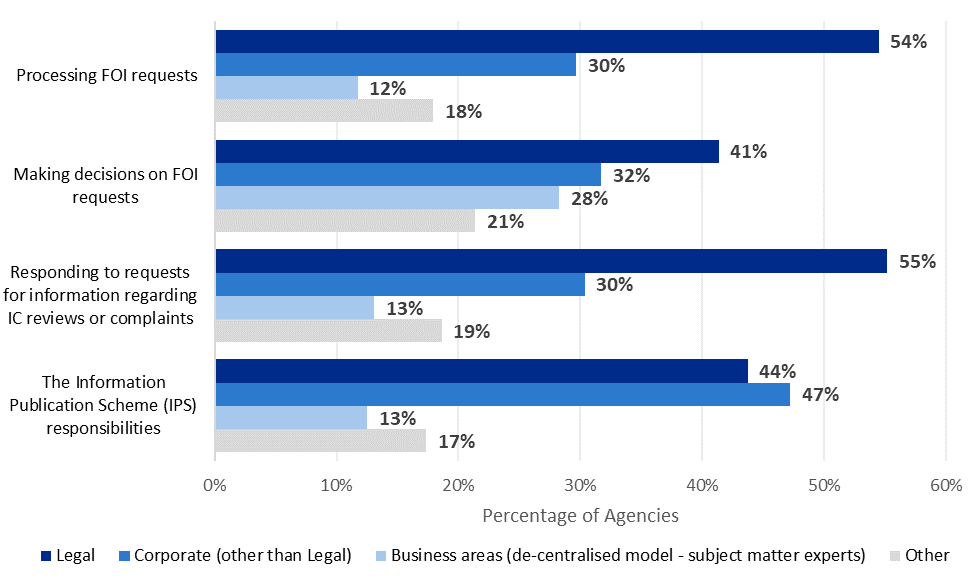
Q7. What area of your organisation is responsible for processing FOI requests?
Q8. What area of your organisation is responsible for making decisions on FOI requests?
Q9. What area of your organisation is responsible for responding to requests for information regarding Information Commissioner reviews or complaints?
Q12. What area of your organisation is responsible for the Information Publication Scheme (IPS) responsibilities?
Analysis of these findings by agency size shows that:
- Small-sized agencies most commonly reported corporate as the area responsible for the management of their obligations under the FOI Act, and
- Medium-sized and large sized-agencies most commonly reported legal as the area responsible for the management of these obligations.
Most cited areas responsible for managing obligations (by agency size) | ||||
|---|---|---|---|---|
Obligation Type | Small (n=73) | Medium (n=30) | Large (n=33) | |
Processing FOI Requests | Corporate (44%) Legal (39%) | Legal (77%) | Legal (73%) | |
Making Decisions on FOI Requests | Corporate (41%) Legal (34%) Other (25%) Business Areas (24%) | Legal (50%) Corporate (33%) Business Areas (23%) | Legal (52%) Business Areas (36%) | |
Responding to requests for information regarding IC reviews or complaints | Corporate (46%) Legal (37%) Other (20%) | Legal (83%) | Legal (76%) | |
IPS responsibilities | Corporate (54%) Legal (28%) Other (20%) | Legal (66%) Corporate (41%) | Legal (64%) Corporate (36%) | |
Note: Responses are listed in the table if greater than a threshold of 20%.
Analysis of these findings by agencies with different number of FOI requests shows that:
- Agencies with a small number of FOI requests reported corporate as the area responsible for the management of most of their obligations (except for processing FOI requests), and
- Agencies with medium or high number of FOI requests most commonly reported the legal area is responsible for all of their obligations.
Most cited area responsible for managing obligations (by number of FOI requests) | ||||
|---|---|---|---|---|
Obligation Type | Low (n=49) | Medium (n=48) | High (n=27) | |
Processing FOI Requests | Legal (43%) Corporate (41%) | Legal (72%) Corporate (21%) | Legal (78%) Other (26%) Business Areas (22%) | |
Making Decisions on FOI Requests | Corporate (41%) Legal (27%) Other (27%) Business Areas (27%) | Legal (57%) Corporate (28%) Business Areas (28%) | Legal (59%) Business Areas (41%) | |
Responding to requests for information regarding IC reviews or complaints | Corporate (45%) Legal (39%) Other (24%) | Legal (74%) | Legal (78%) Other (22%) Business Areas (22%) | |
IPS responsibilities | Corporate (53%) Legal (33%) | Legal (57%) Corporate (41%) | Legal (70%) Business Areas (26%) Corporate (26%) Other (22%) | |
Note: Responses are listed in the table if greater than a threshold of 20%.
Figure 4 shows that 14% of agencies reported that their agencies provide administrative support for the management of FOI functions to a minister.
- Large agencies were much more likely (48%) to provide administrative support for the management of FOI functions to a minister.
Of those who reported this, 67% of agencies indicated the legal area was responsible for providing this administrative support, with 33% managing this through a ministerial support branch or unit.
Figure 4: Agencies that provide administrative support for the management of FOI functions to a minister and the areas responsible for providing this administrative support
Base: All agencies (n = 145) and agencies who provide support (n = 21).
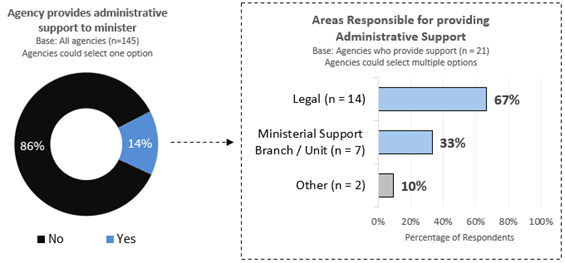
FOI reporting systems and approaches
Figure 5 shows 63% of agencies reported using an Excel spreadsheet or other static record to manage and report on FOI requests, while 26% use a case management system.
Figure 5: Agencies that provide administrative support for the management of FOI functions to a minister and the areas responsible for providing this administrative support
Base: All agencies (n = 144). Agencies could provide multiple response options.
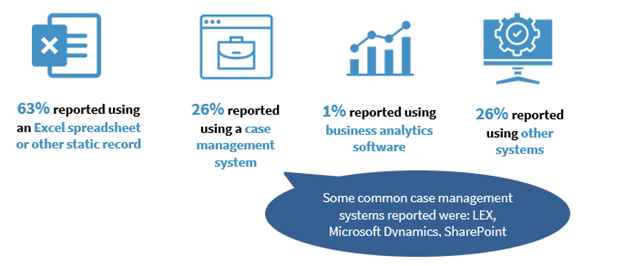
The below table shows that:
- Excel spreadsheets or other static records was the most used system to manage and report on FOI requests for small and medium sized agencies and for those agencies with a low or medium number of FOI requests.
- In contrast, case management systems were more commonly used by larger agencies and agencies with a high number of FOI requests.
Most used systems | ||||
|---|---|---|---|---|
By agency size
| Small (n=73) | Medium (n=30) | Large (n=33) | |
Excel or other static record (67%) Other (33%) | Excel or other static record (70%) Case management system (27%) | Case management system (61%) Excel or other static record (48%) | ||
By number of FOI requests | Low (n=49) | Medium (n=48) | High (n=27) | |
Excel or other static record (60%)
Other (40%) | Excel or other static record (81%) Case management system (28%) | Case management system (70%) Excel or other static record (33%) | ||
Note: Responses are listed in the table if greater than a threshold of 20%
Q13. What systems do you use to manage and report on FOI requests? [Please select all that apply]
Reporting arrangements
The below table show 65% of agencies indicated they provide reports on FOI functions to their Executive or Board, 34% providing reports to a Director, 17% to an Audit and Risk Committee and 12% to a Deputy Secretary. Eight per cent of agencies (mostly small agencies with a low number of FOI requests) indicated they had no FOI reporting arrangements in place.
The most common frequency of reporting arrangement is weekly, except for reports provided to the Audit and Risk committee, where the most common frequency of reporting arrangement is on a quarterly basis.
FOI reporting arrangements
Base: All agencies (n=146).
Reporting Arrangement (Multiple response) | % of agencies citing reporting arrangement | Most common frequency of reporting arrangement (Single response) |
Provided to the Executive or the Board | 65% | Weekly (27% of agencies who reported specified reporting arrangement) |
Provided to a Director | 34% | Weekly (35%) |
Provided to the Audit and Risk Committee | 17% | Quarterly (76%) |
Provided to a Deputy Secretary | 12% | Weekly (72%) |
Other reporting arrangements | 25% | Other reporting frequencies (53%) e.g. as required, fortnightly, on receipt of FOI request |
No Reporting Arrangements | 8% | Not Applicable |
Training and guidance
Agencies were asked how FOI Act training is usually provided (primary method) and other ways it is provided (secondary method) within their agency. Figure 6 shows that:
- Most agencies use Informal, on the job training (79%) and Internal Resources (69%) for FOI Act training. Around a quarter of agencies use these as their primary training method.
- Internal Legal Services (39%) and AGS (42%) are common primary and secondary training methods.
- Internal online training and external service providers are typically only used as secondary training methods.
Figure 6: How is FOI Act training usually provided (primary) and what other ways does your agency provide FOI Act training (secondary)?
Base: All agencies (n=145). Agencies could select one primary and multiple secondary response options.
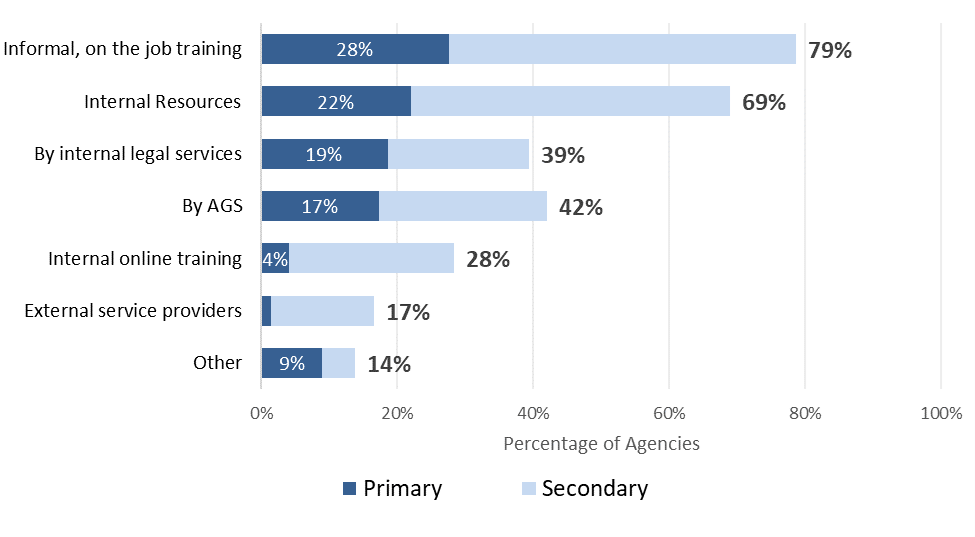
Q16. How is FOI Act training usually provided within your agency?
Q17. What other ways does your agency provide FOI Act training? [Please select all that apply] [Do not show response selected in Q16]
Figure 7 shows that 82% of agencies indicated that the FOI Guidelines is the information that assists them most in performing FOI Act functions, while the remaining 18% reported using:
- guidance provided by the AGS (7%)
- their agency’s publications e.g. manuals, guidance (2%)
- other OAIC guidance (1%)
- other sources of information (8%).
Figure 7: What information do you use most to assist you in performing your FOI Act functions?
Base: All agencies (n=145). Agencies could only select one response option.
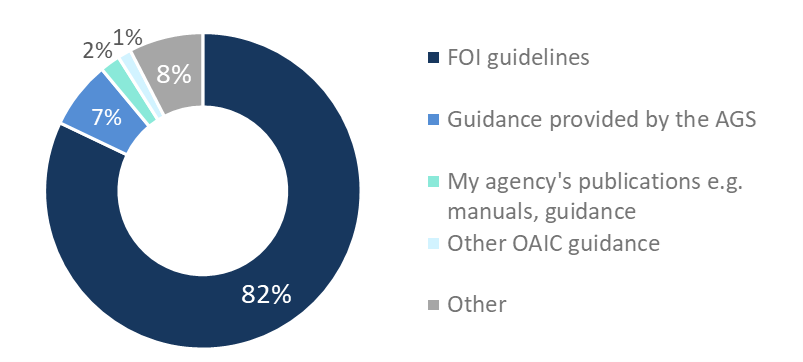
Q18. What information do you use most to assist you in performing your FOI Act functions?
- Figure 8 shows that over half of agencies (58%) indicated they use OAIC resources regularly: at least weekly (32%), fortnightly (13%) or monthly (13%). Around one-third of agencies reported using them occasionally, while 11% indicated they use them rarely or never use them.
Figure 8: How frequently do you use OAIC resources?
Base: All agencies (n=146). Agencies could only select one response option.

Agencies were asked to rank 5 OAIC resources based on how frequently they are used. The rankings were recorded on a scale of 1 to 5, where 1 is most frequently used, and 5 is least frequently used. On average, FOI guidelines was ranked as the most frequently used by agencies, receiving an average ranking of 1.24, while other OAIC resources received an average ranking between 3 and 4.
Agencies were also asked to rate the helpfulness of each resource on a scale of 1 (not helpful at all) to 10 (very helpful). The FOI guidelines were also ranked the highest for average helpfulness (8.61), with the other resources ranging between 6.58 (ICON Alert) to 7.33 (FOI Essentials Toolkit).
Frequency of use and helpfulness of OAIC resources
Base: All agencies (n=133 – 137).
OAIC Resource | Average Frequency Rank 1 (most) to 5 (least) frequently used | Average Helpfulness Rating 1 (Not helpful at all) to 10 (Very helpful) |
|---|---|---|
FOI Guidelines | 1.24 | 8.61 |
FOI Essentials Toolkit | 3.01 | 7.33 |
General website publications | 3.29 | 6.97 |
IC Review Procedure Direction | 3.51 | 6.80 |
ICON alert | 3.99 | 6.58 |
Figure 9 shows that OAIC resources with higher frequency of use were rated more helpful on average – with a strong positive correlation between the frequency of use rating and helpfulness rating.
Figure 9: Correlation between average rank of the frequency of use of OAIC resources and the average helpfulness of the resource
Base: All agencies (n=133 – 137).
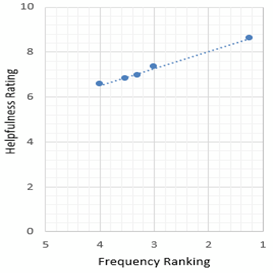
Q20. Please rank the following OAIC resources from most (1) to least (5) frequently used.
Q22. How would you rate the helpfulness of the following OAIC FOI guidance publications?
Agencies were asked if there were any other OAIC resources that they used frequently. The most cited responses included:
IC and OAIC Decisions:
- ‘Decisions published by the OAIC, and template letters.’
- ‘IC Review decisions.’
- ‘Recent decisions from OAIC, OAIC webinars.’
- ‘OAIC website and associated links and templates’
Freedom of Information Guidance for Government agencies:
- ‘FOI Guidelines’
- ‘Reporting guidelines’
- ‘FOI stats guide’
- ‘https://www.oaic.gov.au/freedom-of-information/freedom-of-information-guidance-for-government-agencies.’
Privacy information and resources:
- ‘Australian Privacy Principles guidelines.’
- ‘Privacy Act relevant material.’
- ‘Privacy guidance for government agencies.’
Q21. Are there any other OAIC resources that you use frequently?
Agencies were asked to provide brief comments to explain their helpfulness rating for various resources. The most common responses included:
The FOI guidelines are very useful and the first point of reference:
- ‘The FOI Guidelines are the first resource used.’
- ‘As a standard-setter we appreciate the value of the Guidelines. The Guidelines are the first place we would refer to.’
- ‘The FOI Guidance publications assist providing essential information and guidance material for FOI officers within our agency, regardless of the existing level of FOI experience and knowledge each person has.’
Agencies were often unaware of other resources or did not use them often:
- ‘I have never used/was not aware of ICON alert or Information Commissioner Review Procedure Direction, which is why I scored both very low’
- ‘FOI Guidelines and Information Commissioner Review Procedure Direction very clearly set out expectations and are valuable to the agency's understanding of FOI Act expectations. Other resources are user friendly however not utilised as often.’
- ‘Guidance very helpful. Was previously unaware of ICON service, but have now contacted ICON service to be added to distribution list.’
Q23. Please provide brief comments to explain your answer to the previous question.
The previous question was:
Q22. How would you rate the helpfulness of the following OAIC FOI guidance publications?
Future needs
Agencies were asked to rank the types of guidance from most (1) to least (4) helpful in responding to FOI requests. The table below shows that fact sheets/aids were ranked as the most helpful overall, whereas templates, e-learning modules and training were ranked as less helpful. This table also shows that the helpfulness ranking for fact sheets/aids was even higher for those agencies with a high number of FOI requests (1.48 average ranking), than agencies with a medium (1.73) or low (1.71) number of FOI requests.
Helpfulness of OAIC guidance in responding to FOI requests
Base: All agencies (n=142 – 143).
Types of Guidance | Average helpfulness ranking 1 (most) to 4 (least) helpful | Ranking by number of FOI requests | |
|---|---|---|---|
Fact sheets/aids to explain specific issues | 1.70 | Low | 1.71 |
Medium | 1.73 | ||
High | 1.48 | ||
Templates to use in exercising functions | 2.60 | Low | 2.65 |
Medium | 2.60 | ||
High | 2.67 | ||
E-learning modules to explain the operation of the FOI Act | 2.65 | Low | 2.62 |
Medium | 2.77 | ||
High | 2.67 | ||
Training in decision making | 3.04 | Low | 3.00 |
Medium | 2.90 | ||
High | 3.19 | ||
Q24. Please rank the following types of guidance from most (1) to least helpful (4) in responding to FOI requests.
Agencies were asked if there were any other types of guidance that they find helpful. The most cited responses included:
Templates, flowcharts and process timelines (some of which were noted):
- ‘Detailed processes/communication channels with respect to IC Reviews and Submissions.’
- ‘Additional processing flowcharts, decision summaries, Fact Sheet/aid to explain review rights, practical examples for training.’
- ‘Templates to calculate timeframes.’
- ‘Timelines of the OAIC IC review Applications i.e. timeframes, how to contact the officer directly to ask specific questions’
IC review matters and decisions:
- ‘IC review decisions, which can provide relevant general commentary.’
- ‘Summary of IC review matters.’
- ‘IC review decisions - up-dates’
AGS resources:
- ‘AGS advice.’
- ‘AGS case notes and AAT cases.’
- ‘AGS Training Sessions.’
A few agencies provided suggestion of resources that would be helpful if provided, including telephone support to answer queries and specific templates for small agencies:
- ‘You previously had a service whereby agency staff could contact you by phone or email with a procedural query that was not addressed in other guidance. That was an extremely [helpful] service and would love to see it return.’
- ‘It would be helpful if the OAIC provided telephone advice to agencies on FOI issues.’
- ‘Decision templates to help smaller agencies build and craft consistent decisions would be helpful.’
- ‘A procedure with instructions from start to finish would be helpful for small agencies that cannot resource a specific FOI team.’
Q25. Are there any other types of guidance that you find helpful?
Agencies were asked which formats are or would be most effective (up to three) in providing guidance on FOI matters. Figure 10 shows that agencies reported that templates (74%) and targeted written guidance (73%) would be the most effective, followed by checklists (57%) and e-learning modules (48%). Alternative options such as newsletters and animations were reported by less than 15% of agencies.
Figure 10: Which of the following formats are or would be most effective (up to three) in providing guidance on FOI?
Base: All agencies (n=143). Agencies could select up to 3 options.
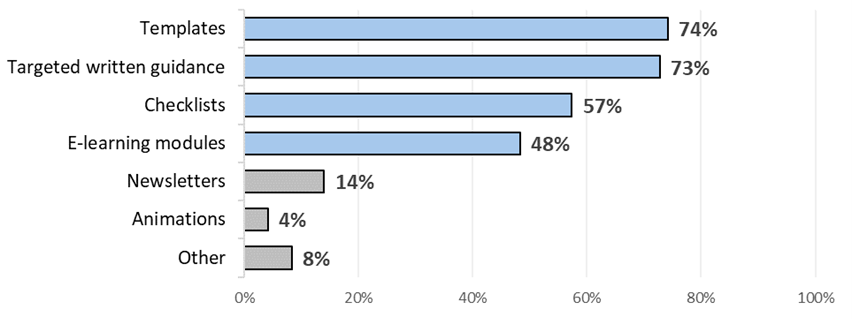
Q26. Which of the following formats are or would be most effective (up to three) in providing guidance on FOI? [Please select up to three options]
Agencies were also asked which subject matter guidance would assist them most (up to five) in responding to FOI requests. Figure 11 shows that over 60% of agencies reported conditional exemptions (73%), exemptions (71%), decision making (68%), procedural requirements (64%) and practical refusals (63%) as providing most assistance.
Figure 11: Which of the following subject matter guidance would assist you most (up to five) in responding to FOI requests?
Base: All agencies (n=142). Agencies could select up to 5 options.
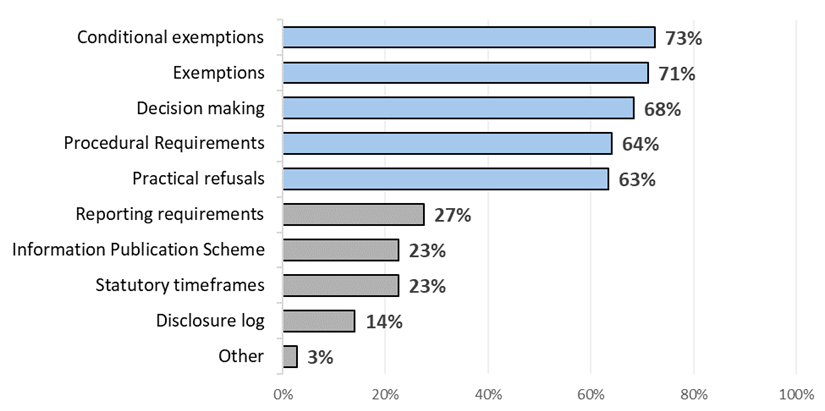
Q27. Which of the following subject matter guidance would assist you most (up to five) in responding to FOI requests? [Please select up to five options]
Figure 12 shows that 84%of agencies indicated that relevant staff are subscribed to receive the OAIC’s ICON alerts:
- 58% of agencies reported that staff are subscribed individually (with just under half of these agencies indicating all relevant staff are subscribed individually)
- 38% reported their organisation is subscribed through a shared mailbox (e.g. the FOI operational mailbox).
Figure 12: Are relevant staff subscribed to receive the OAIC’s ICON alerts?
Base: All agencies (n=144). Agencies could select multiple response options.
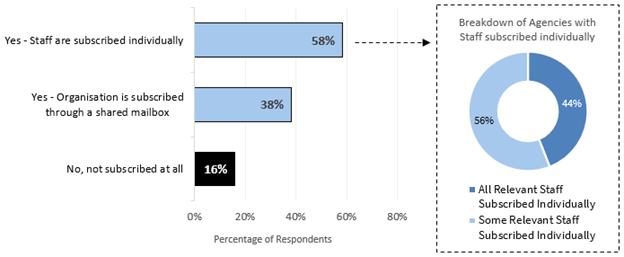
Q28. Are relevant staff subscribed to receive the OAIC’s ICON alerts? [Please select all that apply]
[1] For analysis and reporting purposes, “small” agencies include micro, extra small and small-sized agencies, “medium” agencies include medium-sized agencies and “large” agencies include large and extra large-sized agencies.
[2] For analysis and reporting purposes, “low requests” agencies include agencies with low number of FOI requests, “medium requests” agencies include agencies with medium number of FOI requests and “high requests” agencies include agencies with high and very high number of FOI requests.

